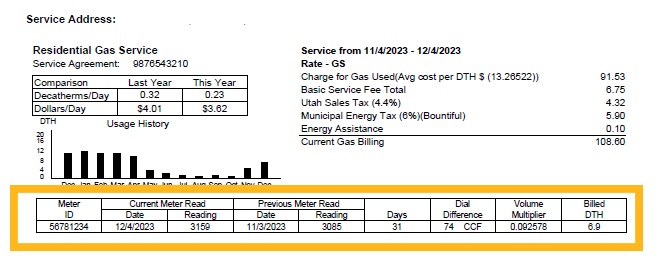Everything you need to know about your Enbridge Gas bill
To better understand the various charges and terms that appear on your bill, view the bill samples in the sections below and refer to the details for each numbered item.
Billing and payment summary

1. Account summary
This statement shows your previous balance due, payments received and current charges.
2. Total amount due upon receipt
The total of the three parts of the account summary.
Usage history
3. Comparison
This table compares this year’s natural gas usage against last year’s usage, measured in average Dekatherms (DTH) per day and average dollars spent per day.
4. Usage history
This chart shows your monthly natural gas usage for the last 13 months.

Current meter and usage

5. Meter data table
This table shows the various data from your meter (such as current meter read and previous meter read) that is used to determine your natural gas usage for the current month.
6. Billed DTH
Billed DTH (decatherms) is determined by multiplying the dial difference (which is the difference between your current meter read and previous meter read) by the volume multiplier.
Explanation of charges
7. Service charges, taxes and fees
This section lists the charges that make up your bill. For more details on these charges, please refer to the applicable rates and tariff.
8. Charge for gas used
This cost is determined by multiplying billed DTH by the average cost per DTH (this average is comprised of non-gas costs and gas costs). Learn about gas costs.
9. Current gas billing
The total of all service charges, taxes and fees (point 7 as shown above) for the current month. This sum is factored into the account summary to calculate total amount due upon receipt.

Additional resources
-

How to read your meter
Your meter tracks your natural gas usage, in cubic feet, much like a car odometer counts the cumulative total of miles driven. -

Billing inserts
Stay in the loop with our recent bill inserts and customer communications. -

Understanding gas costs
An overview of how the cost of natural gas supplies can affect your bill over time. -

Estimated bill FAQs
Read frequently asked questions about an estimated bill.








